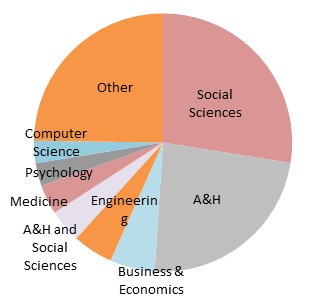Scopus Content update: 75,000 book titles and counting
"If we encounter a man of rare intellect, we should ask him what books he reads." — Ralph Waldo Emerson, Letters and Social Aims (1876), Quotation and Originality.
With more than 75,000 additional book titles now indexed in Scopus (and another 45,000 planned for 2015), it is easier to uncover the bounty of literature supporting great intellect.
The arts and humanities and social sciences represent more than 55% of the 75,000 titles (see graph below). Not surprising considering 80% of arts and humanities and social sciences output is published in books instead of journals (1).
In a 2013 Research Trends article, Dr. Alesia Zuccala, an Assistant Professor at the University of Copenhagen, states that “the key to sustainability [for humanities research] is to develop relevant evaluation methods…”(2). The expanding book coverage, combined with the strength of Scopus in bibliographic search, discoverability and evaluation tools, allows you to measure the impact and scholarly achievement of the humanities in a more quantitative way — filling a gap in evaluation methods.The improved ability to create book-based citation analyses for evaluating research is a significant development across all disciplines. The resulting expansion of author data in Scopus can enhance an author’s profile and h-index — especially if you are an author whose primary method of disseminating information is through books rather than journals. Likewise, for administrators, expanded metrics mean you can better evaluate disparate disciplines.
The role of books in science and technology is also growing, according to Suzanne BeDell, Managing Director of Elsevier Science and Technology Books, as they “tend to present a broader view of a particular subject, bring in diverse viewpoints on that subject, and treat the subject in an interdisciplinary way.” The additional book coverage means better ability to “use data and analytics to gain insights into the world’s research trends,” something Suzanne highlights as a key developing area of interest in a recent Elsevier Connect article (3).
In summary, there is a threefold impact to including quality book content in Scopus: It significantly increases subject area coverage for book-based disciplines, fosters interdisciplinary collaboration across subject areas, and fills a gap in evaluation methods.
Next time you run a search in Scopus or view an author’s profile, look for the increase in book content.
Video: Watch how book content in Scopus leads you to further insights and information, discover key influencers in your field and identify potential collaborators.
Public book list: View a list of which books are now included in Scopus.
About the data: Providing reliable metrics requires accurate data gathered from quality sources. The books selected and indexed in Scopus must undergo a rigorous selection process before they are added (as does all Scopus content). Once selected, the Scopus content team creates the metadata directly from the full text of a title. This ensures that only the most accurate data and citation information from quality books are used. Learn more about Scopus content policy and selection criteria.
- Linda Butler. Australian research output by field and publication category, Australian National University, 2007.
- Alesia Zuccala, “Evaluating the Humanities: vitalizing ‘the forgotten sciences’,” Research Trends, March 2013.
- Harald Boersma, “Elsevier leaders look at 2015 trends in STM publishing,” Elsevier Connect, March 2015.




